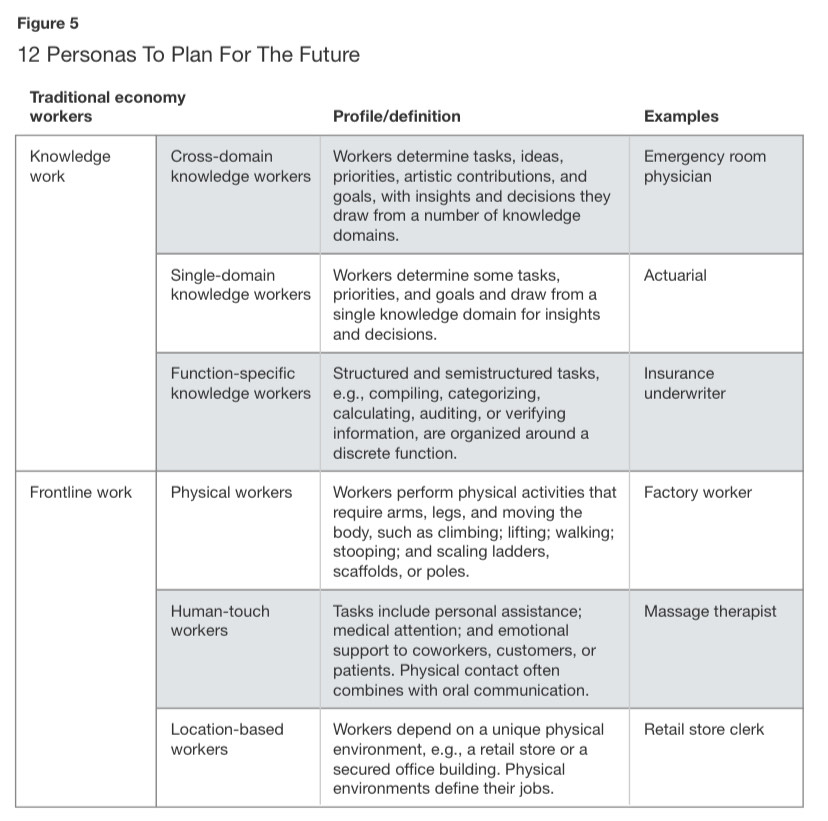Weaponize your workers as robots take over
Whether companies like it or not, digital transformation is coming for them—and so far, the most transformative tool has been automation. While there are tasks that robots will do better than humans, not all roles need replacing, and there is a way for companies to see where workers like yoga instructors, massage therapists, retail store clerks and factory workers fit into an automated environment, says a report by research-based consultancy firm Forrester Consulting.
According to “The Future of Work is Still Being Written: But Who is Holding the Pen,” for businesses to maximize automation and plan for their future more efficiently, they should understand the 12 “automation personas” and how they fit into the organization’s business. The report says these personas are based on four “traditional” job categories: Knowledge work, frontline work, administrative work and emerging models of work.
Winners or losers?
Under knowledge work, there are three personas:
Cross-domain knowledge workers, or those who “determine tasks, ideas, priorities, artistic contributions, and goals, with insights and decisions they draw from a number of knowledge domains.” The report’s primary example of this persona is the emergency room physician.
Single-domain knowledge workers. These employees are much like the first persona, but instead draw insights and decisions from a single knowledge domain. Primary example: An actuary, or a professional who “deals with the measurement and management of risk and uncertainty” in a business.
Function-specific knowledge workers. Like an insurance underwriter, these workers perform structured and semi-structured tasks, such as compiling, categorizing, calculating, auditing or verifying information.
Frontline work also encompasses three personas:
Physical workers. Like the name suggests, these workers perform activities that require the use of their arms and legs, as well as moving their body (climbing, lifting, walking, stooping, and scaling ladders, scaffolding or poles). Factory workers are the No. 1 example.
Human touch workers, or those who provide personal assistance, medical attention and emotional support—like massage therapists, who combine physical touch with oral communication.

Administrative work focuses on two personas:
Coordinators. An example would be a fleet manager, who mainly deals with administrative, staffing, monitoring or controlling activities.
Cubicle workers. An accounts payable administrator is an example. These workers are usually tasked with repetitive and structured work in back-office and front-office positions (those with BPO functions also fall under this persona).
Will yogi find the ohm?
Finally, under emerging models of work, there are four:
Mission-based workers. Your yoga instructor falls under this persona, as he or she believes “that job satisfaction, work-life harmony and alignment of their values and needs” are relevant work factors.
Teachers/explainers. Like a knowledge-based curator, these workers are adept at curriculum design, teaching and instruction for individuals and groups.
Digital elites. These are your data scientists—the pros in software development, machine learning algorithms and enterprise architecture.
Digital outcasts. Finance and accounting clerks fall under this persona, as the report says they are the kinds of workers who are unable to work effectively with machines, or just find it difficult to transition to digital tech because of issues surrounding skills, attitudes and ambitions.
Forrester’s research was commissioned by global robotic process automation (RPA) vendor UiPath to “evaluate the impact of automation and how firms are enabling better preparedness for the future while considering employee experience.” Forrester conducted in July 2019 an online survey among 270 decision makers in countries including France, Germany, the United Kingdom and the United States.
The survey’s results paint a bright future for automation: 66 percent of companies said their RPA software spending would increase by at least 5 percent in the next year. Forrester’s prediction is that by 2023, the RPA services market will be worth $12 billion.
Automate or die
Company managers believe RPA “will lead to more productive and more efficient working environments by removing repetitive work,” the report states.
As they automate, companies, of course, still need to address the issue of job loss. Among the 12 aforementioned personas, those that could be most affected are the cubicle workers, whose tasks are repetitive; and the digital outcasts.
Forrester recommends the following:
Proactively address the 12 work personas. Organize, survey, and personalize programs for each.
Plan a structural change in how you recruit, retain and manage workers.
Look to build new digital certification programs from within, but use external partners to do so.
Recognize that constructive ambitions will reduce deficits. Give employees the chance to adapt to the new technology and “upskill,” and provide incentives so they will want to do so. INQ

